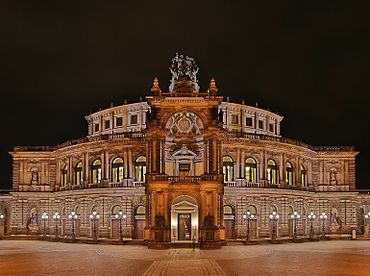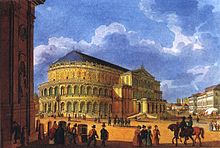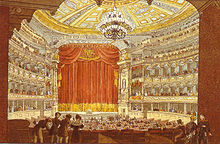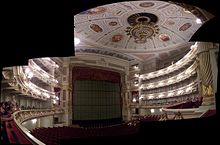- Semperoper
-
The Semperoper is the opera house of the Sächsische Staatsoper Dresden (Saxon State Opera, Dresden) and the concert hall of the Sächsische Staatskapelle Dresden (Saxon State Orchestra, Dresden). It is located near the Elbe River in the historic center of Dresden, Germany.
The opera house was originally built by the architect Gottfried Semper in 1841. After a devastating fire in 1869, the opera house was rebuilt, partly again by Semper, and completed in 1878. The opera house has a long history of premieres, including major works by Richard Wagner and Richard Strauss.
Contents
History
The first opera house at the location of today's Semperoper was built by the architect Gottfried Semper in 1841. Its opening was on April 13, 1841 with an opera by Carl Maria von Weber. The building style itself is debated among many, as it has features that appear in three styles; Early Renaissance and Baroque, with Corinthian style pillars typical of Greek (classical revival). Perhaps the most suitable label for this style would be eclecticism, where influences from many styles are used, a practice most common during this period.[1] Nevertheless, the opera building, Semper's first, is regarded as one of the most beautiful European opera houses.
Following a devastating fire in 1869, the citizens of Dresden immediately set about rebuilding their opera house. They demanded that Gottfried Semper do the reconstruction, even though he was then in exile because of his involvement in the May 1849 uprising in Dresden. The architect had his son, Manfred Semper, build the second opera house using his plans. Completed in 1878, it was built in Neo-Renaissance style. During the construction period, performances were held at the Gewerbehaussaal, which opened in 1870.[1]
The building is considered to be a prime example of "Dresden Baroque" architecture. It is situated on the Theater Square in central Dresden on the bank of the Elbe River. On top of the portal there is a Panther quadriga with a statue of Dionysos. The interior was created by architects of the time, such as Johannes Schilling. Monuments on the portal depict artists, such as Johann Wolfgang von Goethe, Friedrich Schiller, William Shakespeare, Sophocles, Molière and Euripides. The building also features work by Ernst Rietschel and Ernst Julius Hähnel.[2]
In the pre-war years, the Semperoper premiered many of the works of Richard Strauss.
In 1945, during the last months of World War II, the building was destroyed again, this time by the bombing of Dresden and subsequent firestorm. Exactly 40 years later, on February 13, 1985, the opera's reconstruction was completed. It was rebuilt to be almost identical to its appearance before the war.[3] The Semperoper reopened with the opera that was performed just before the building's destruction in 1945, Carl Maria von Weber's "Der Freischütz".
When the Elbe flooded in 2002, the building suffered heavy water damage. With substantial help from around the world, it reopened in December that year.
Present
Today, the orchestra for most operas is the Sächsische Staatskapelle Dresden. The Generalmusikdirektor (GMD) of the Semperoper is normally a different person as for the Staatskapelle in concert, with the exceptions of Karl Böhm, Hans Vonk and Fabio Luisi, who held both positions. Luisi resigned as chief conductor of the Semperoper in February 2010,[4] to be succeeded by Christian Thielemann in the 2012/13 season.[5]
For the 2011/12 season, the Semperoper is offering 19 premieres, including eight operas, five ballet productions, two gala evenings and four productions of the youth programme, Junge Szene.[6]
Artists associated with the Semperoper
Conductors
- Carl Gottlieb Reißiger
- Richard Wagner
- Ernst von Schuch
- Fritz Reiner (1914–1921)
- Fritz Busch (1922–1933)
- Karl Böhm (1934–1942)
- Karl Elmendorff (1943–1944)
- Joseph Keilberth (1945–1951)
- Rudolf Kempe (1949–1952)
- Otmar Suitner (1960–1964)
- Kurt Sanderling (1964–1967)
- Herbert Blomstedt (1975–1985)
- Hans Vonk (1985–1990)
- Giuseppe Sinopoli (1992–2001)
- Semyon Bychkov (2001–2002)
- Bernard Haitink (2002–2004)
- Fabio Luisi (2004–2012)
- Christian Thielemann (from 2012)
Singers
- Bernd Aldenhoff
- Elisabeth Höngen
- Elisabeth Rethberg
- Ernestine Schumann-Heink
- Erna Sack
- Therese Malten
- Edda Moser
- Hermann Wedekind
- Marie Wittich
Operas that premiered at the Semperoper
- 1842: Wagner - Rienzi, 20 October 1842
- 1843: Wagner - Der fliegende Holländer ( The Flying Dutchman), 2 January 1843
- 1845: Wagner - Tannhäuser, 19 October 1845
- 1895: Eugen d’Albert: Ghismonda, 28. November 1895
- 1901: Richard Strauss - Feuersnot, 22 November 1901
- 1905: Richard Strauss - Salome, 9 December 1905
- 1909: Richard Strauss - Elektra (opera), 25 January 1909
- 1911: Richard Strauss - Der Rosenkavalier, 26 January 1911
- 1913: Ermanno Wolf-Ferrari - L'amore medico, 4 December 1913
- 1916: Eugen d’Albert - Die toten Augen, 5 March 1916
- 1917: Hans Pfitzner - Das Christ-Elflein (2nd version), 11 December 1917
- 1924: Richard Strauss - Intermezzo, 4 November 1924
- 1925: Ferruccio Busoni - Doktor Faust, 21 May 1925
- 1926: Kurt Weill - Der Protagonist, 27 March 1926
- 1926: Paul Hindemith - Cardillac, 9 November 1926
- 1926: Kurt Weill - Der Protagonist
- 1927: Emil von Reznicek - Spiel oder Ernst
- 1927: Othmar Schoeck - Penthesilea , 8 January 1927
- 1928: Richard Strauss - Die ägyptische Helena, 6 June 1928
- 1930: Schoeck - Vom Fischer and syner Fru, 3 October 1930
- 1932: Eugen d'Albert - Mr Wu
- 1933: Richard Strauss - Arabella, 1 July 1933
- 1935: Richard Strauss - Die schweigsame Frau, 24 June 1935
- 1935: Rudolf Wagner-Régeny - Der Günstling, 20 February 1935
- 1937: Schoeck - Massimilla Doni, 2 March 1937
- 1938: Richard Strauss - Daphne, 15 October 1938
- 1940: Heinrich Sutermeister - Romeo und Julia, 13 April 1940
- 1942: Heinrich Sutermeister - Die Zauberinsel, 31 October 1942
- 1944: Gottfried von Einem - Prinzessin Turandot, 5 February 1944
- 1944: Joseph Haas - Die Hochzeit des Jobs, 2 July 1944
- 1985: Siegfried Matthus - Die Weise von Liebe und Tod des Cornets Christoph Rilke, 16 February 1985
- 1989: Eckehard Meyer - Der goldene Topf, 1989
- 1998: Matthias Pintscher - Thomas Chatterton, 25 May 1998
- 2001: Peter Ruzicka - Celan, 25 March 2001
- 2008: Manfred Trojahn - La grande magia, 10 May 2008
See also
References
- ^ a b Fritz Löffler: Das alte Dresden - Geschichte seiner Bauten. 16th ed. Leipzig: Seemann, 2006, ISBN 9783865020000 (German)
- ^ "Dresden Semperoper". Mostly Opera. http://mostlyopera.blogspot.com/2008/10/dresden-semperoper.html. Retrieved 9 August 2009.
- ^ "Dresden Sights and Views - Semper Opera House -". sights-and-culture.com. http://www.sights-and-culture.com/Germany/dresden-semper-opera.html. Retrieved 9 August 2009.
- ^ Daniel J. Wakin (2010-02-04). "Saxon State Opera's Music Director Quits". New York Times. http://www.nytimes.com/2010/02/05/arts/music/05fabio.html. Retrieved 2010-02-06.
- ^ "Christian Thielemann Chefdirigent ab 2012" (Press release). Sächsische Staatskapelle Dresden. 9 October 2009. http://www.staatskapelle-dresden.de/staatskapelle/christian-thielemann. Retrieved 4 December 2010.
- ^ "History of the Semperoper". www.semperoper.de. 2011. http://www.semperoper.de/en/haus/geschichte-der-semperoper.html. Retrieved 17 November 2011.
External links
- Semperoper official website
- History of the Semperoper
Coordinates: 51°03′16″N 13°44′07″E / 51.05444°N 13.73528°E
Categories:- Buildings and structures completed in 1841
- Buildings and structures completed in 1878
- Opera houses in Germany
- Buildings and structures in Dresden
- Visitor attractions in Dresden
- Neo-Baroque architecture
- Rebuilt buildings and structures in Germany
Wikimedia Foundation. 2010.





